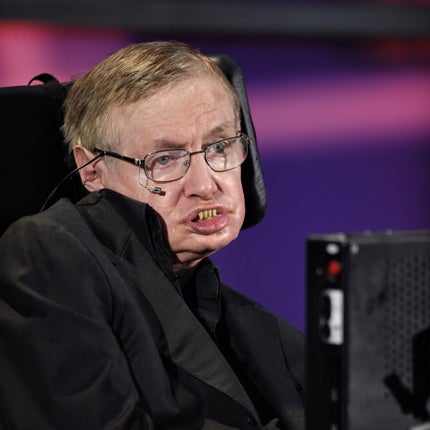Your support helps us to tell the story
From reproductive rights to climate change to Big Tech, The Independent is on the ground when the story is developing. Whether it's investigating the financials of Elon Musk's pro-Trump PAC or producing our latest documentary, 'The A Word', which shines a light on the American women fighting for reproductive rights, we know how important it is to parse out the facts from the messaging.
At such a critical moment in US history, we need reporters on the ground. Your donation allows us to keep sending journalists to speak to both sides of the story.
The Independent is trusted by Americans across the entire political spectrum. And unlike many other quality news outlets, we choose not to lock Americans out of our reporting and analysis with paywalls. We believe quality journalism should be available to everyone, paid for by those who can afford it.
Your support makes all the difference.Asked by: Richard Woolley, Cardiff
Answered by: Ulf Leonhardt, Chair in Theoretical Physics, University of St Andrews
Who were the first people to think about black holes?
The 18th-century mathematician Pierre-Simon Laplace was one of the first to discuss the wider effects of celestial bodies exerting a gravitational pull on their surroundings. He explored the idea of an "escape velocity", the necessary speed for objects to overcome this gravitational force and move away from stars or planets. He argued that a gravitational force could be so high, when produced by an especially dense body, that even light would have a problem escaping. These "dark stars" were essentially early models of black holes.
At the turn of the 20th century, with the publication of Albert Einstein's theory of relativity, scientists realised that it was impossible for an object to travel faster than the speed of light. This had repercussions for the "maximum density" which a black hole could have.
Another key contributor to black hole theory was American theoretical physicist Robert Oppenheimer, most famous for his role as scientific director of the Manhattan Project, the drive to develop the first atomic bomb during, who worked in cosmology before venturing into atomic science. He realised that if stars became too heavy and reached the end of their life, they collapsed to form a black hole.
So are black holes really black?
Well, no. Certainly according to theoretical physicist Stephen Hawking.
In the 1970s he realised that black holes could emit radiation (light is a form of radiation) under certain conditions.
His theorising is complex, but he essentially argued that the smaller a black hole, the hotter it gets. Hot black holes have a short life, and emit radiation before they disappear. Quantum mechanics dictates that particles of matter and anti-matter are constantly appearing and disappearing across the universe. Because the presence of both type of particles normally has a cancelling effect, this normally has no effect. However, at a black hole, one of these two particles, which effectively act in opposition, might escape, in the form of radiation, and the other could be trapped by the overwhelming forces of gravity. Hence the emission of this "Hawking radiation".
The place where this process occurs in a black hole is known as an "event horizon"; it is especially interesting to scientists because it is where the effects of quantum mechanics (which affects very small particles) and general relativity (which concerns the speed of light) collide.
Has this ever been proved?
Until now, no. Hawking's postulations were purely theoretical, simply because the high speeds and densities needed to simulate a black hole are hard to recreate in a laboratory.
But recently Daniele Faccio of Heriot-Watt University in Edinburgh and Francesco Belgiorno of the University of Milan, inspired by Leonhardt's work on light in glass fibres at the University of St Andrews, managed to find a way of recreating black hole conditions.
Faccio and Belgiorno focused ultrashort pulses of infrared lasers at a wavelength of 1055 nanometres into a piece of glass. Because of the extremely high intensities of these pulses – containing trillions of times the amount of energy as sunlight, say – the properties of the glass were temporarily skewed. In particular, this process boosted the glass's refractive index, or the amount by which the glass slowed down light travelling through it.
The result was a moving point of very high refractive index, equivalent to a physical hill, which acted as a "horizon", similar to a horizon found in a black hole. Light entering the glass behind this "hill" slows as it climbs the hill and is unable to pass through it.
Relative to the slow-moving pulse, they have come to a stop and remain behind the pulse until it has passed through the glass's length. Faccio et al's experiments have shown that in such an environment, new particles of light were created, which corresponded to the properties of Hawking radiation.
So what do the latest revelations mean for black hole science?
This is the most effective experiment to date showing that black holes do in fact emit radiation, a form of light, and that photons, or light parcels, can effectively be emitted from nothing.
Not everyone is ready to agree on the experiment's repercussions, however. Many more experiments are needed to fully get to the bottom of black hole radiation emissions.
Adam Helfer at the University of Missouri in Columbia argues the term Hawking radiation is best reserved for actual black holes with gravitational fields. And that there is a parallel between them to a certain extent, but the laboratory experiments, interesting as they are, do not really bear on the very deep problems which are special to black holes.
Send your science questions to: microscope@independent.co.uk
Subscribe to Independent Premium to bookmark this article
Want to bookmark your favourite articles and stories to read or reference later? Start your Independent Premium subscription today.

Join our commenting forum
Join thought-provoking conversations, follow other Independent readers and see their replies
Comments